Chapter 3-1-Population-liu Dandan 环境生态学英文版本课件
高中生物人教必修3课件 第6章 第1-2节 人口增长对生态环境的影响 保护我们共同的家园

燃料
破坏
(2)应对措施:
人口增长 ①控制________________ 。 ②加大保护资源和环境的力度:
a.植树种草、退耕还林、还草、还湖、防治沙漠化。
b.监控、治理 ___________江河湖泊及海域的污染。
生物多样性 和建立自然保护区。 c.保护___________
生态农业 六章
第1~2节 人口增长对生态环境
的影响和保护我们共同的家园
1 2 自主学习
课程标准 6 指点迷津
3
新知解读
7
训练巩固
4
知识构建
8
直击高考
5
问题释疑
9
课时作业
课程标准
1.探讨人口增长对生态环境的影响。 2.关注全球性生态环境问题。 3.概述生物多样性保护的意义和措施。 4.形成环境保护需要从我做起的意识。
三、保护生物多样性 1.生物多样性的内容 植物、动物和微生物 ,它们所拥有的全 生物圈内所有的____________________ 基因 以及各种各样的_________ 生态系统 ,共同构成了生物多样性。 部______ 2.生物多样性的价值
生态系 统 食用 药用 科学研究
3.保护生物多样性
下列关于人口数量动态的描述中,正确的是( B.出生率是预测未来人口动态的主要依据
)
A.决定人口数量变化的因素只有出生率和死亡率
C.人口数量问题既有其自然生理基础,又有其社会制约
因素
D.人口数量的变化规律与自然界种群数量的消长规律相 符合 [答案] C
[ 解析 ]
本题主要考查种群数量的变化与种群特征的关
成才之路 ·生物
人教版 ·必修3
路漫漫其修远兮 吾将上下而求索
人教版高中生物必修3第6章 生态环境的保护第1节 人口增长对生态环境的影响课件(5)

B [从生态系统的成分分析,雾霾属于非生物的物质和能量,A 正确; 从生态系统的稳定性分析,雾霾说明生态系统的自我调节能力降低,但生 态系统并未崩溃,B 错误;从生态系统的信息传递分析,雾霾可作为物理 信息影响种群繁殖,C 正确;从生态系统的保护分析,雾霾是人类生产和 生活所造成的环境污染,D 正确。]
精品PPT
[归纳总结] (1)人口增长对环境影响的模型(如图)
精品PPT
(2)我国由人口引发的问题 ①我国有关土地面积、草地面积、森林面积等 6 项自然资源总量综合 排序位于世界前列,但人均占有量却明显居后; ②人均耕地远少于世界人均耕地,且有继续减少的趋势; ③人均淡水占有量也远少于世界水平。
精品PPT
2.计划生育是如何起到控制人口数量的作用的?它的实施将使我国 人口的年龄组成发生怎样的变化?
提示:计划生育是通过降低出生率来控制人口数量过快增长的。它的 实施使我国人口出现老龄化的特点,且老龄化速度逐步加快。
精品PPT
[归纳总结] (1)我国人口的发展特点 ①近几百年来的增长曲线接近“J”型。 ②在较长时间内保持增长。 ③人口老龄化速度加快。 ④城镇人口比重加大。
精品PPT
2.人口发展前景 (1)情况:人口基数大,人口仍将在较长时期内持续增长。
①2020年,人口总数要控制在 14.5 亿以内 (不包括香港、澳门特别行政区和台湾省, (2)目标 下同) ②21世纪中叶人口总数达到峰值(15 亿左 右)以后,将开始缓慢下降
精品PPT
二、人口增长对生态环境的影响 1.对环境的影响
精品PPT
人口增长对生态环境的影响 [问题探究] 1.如图是梅托斯早在 1970 年所提出的一个“人口膨胀—自然资源耗 竭—环境污染”的模型,请据图回答下列问题。
环境生态学Chapter 1
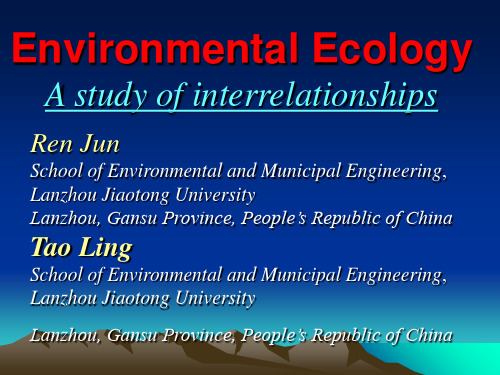
Preface
• The United Nations Conference on Environment and Development was held in Rio de Janeiro in June 1992
Preface
• Environmental ecology includes the study of the relationships between abiotic, biotic and human, the ecological effects of pollution,disturbance, and other stressors.
• The term ecology comes from the Greek oikos meaning "house“ or our environment
• Ecologistscology: study of relationships between organisms and the environment.
•Environmental Science:
The scientific study of the influence of human actions
on natural processes
Environmental Impact
• Environmental impact refers to the alteration of the natural environment by human activity
Tao Ling
School of Environmental and Municipal Engineering, Lanzhou Jiaotong University
高中生物第六章生态环境的保护第1节人口增长对生态环境的影响课件新人教版必修3

4.如图是人类社会与环境相互关系的模式图,识图作答:
第二十六页,共28页。
(1)箭头A表示人类通过生产活动,从环境中获取________。 (2)箭头B表示人类通过消费活动,将________输出给环境。 (3)箭头C表示人类对________产生的影响。 (4)箭头D表示环境对人类的________作用(zuòyòng)。 (5)从生态学角度分析人与环境的关系,可以概括为_______。 (6)要使A、B、C、D达到良性循环,最根本的措施是: ①_____________________________________________。 ②________,只有这样才能实现________战略。
第十四页,共28页。
【典例示范2】 如图是梅托斯早在1970年所提出的一个“ 人口膨胀——自然资源耗竭——环境污染”的模型,请据图回 答下列问题
第十五页,共28页。
(1)在a-b年内粮食水平增长的最可能原因(yuányīn)是什么? (2)简要说出该模型中所包含的道理。 (3)从总的趋势分析该模型存在的缺陷。 (4)应采取怎样的措施来降低人口增长对环境所造成的压力?
第二十二页,共28页。
解析 综合三个图可知,人口数量总是低于环境容纳量,即使(jíshǐ)暂时 高于环境容纳量(图Ⅱ、Ⅲ),最终还是要降下来的。由此可知,环境容 纳量就是指生态系统对人口的承载能力,是一定的,不会随着生产的发 展而扩大。人类活动要以生态系统的稳定为基础,否则将会受到自然环 境的报复。 答案 B
(4)由于我国人口的生育水平迅速下降和平均寿命延长,我国
人口老龄化来势很猛
()
(5)2020年,人口总数要控制在14亿以内,21世纪末人口总数
达到峰值(近15亿)
《人口增长对生态环境的影响 》人教版ppt课件完美版2

•
7.“画竹”是本文的线索,本文记述 文与可 画竹的 情形, 以充满 感情的 笔触回 忆两人 的交往 ,以及 文与可 死后自 己的悲 慨,又 从文与 可的创 作经验 中总结 出艺术 创作的 规律, 熔叙事 、抒情 、议论 于一炉 。
•
8.总之,说明文中使用生动活泼的语 言,不 仅能增 强文章 内容表 达上的 形象性 、可感 性和文 学色彩 ,使读 者获得 不同程 度的美 感体验 ,受到 美的陶 冶,还 有助于 加深读 者对说 明内容 的理解 ,增知 益智。
生物多样性的概念
一般可分为三个层次:
基因多样性 物种多样性 生态系统多样性
生物多样性价值 (1)潜在价值
潜在使用价值
一旦灭绝, 无法再生
一种不起眼的、当柴 烧的植物——三叉苦
(过去)
生物多样性价值
(1)潜在价值 (2)间接价值
间接使用价值
• 指生物多样性具有重要的生态功能
《人口增长对生态环境的影响 》人教版ppt课件完美版2
感谢观看,欢迎指导!
《人口增长对生态环境的影响 》人教版ppt课件完美版2
•
5.在乡土社会里,地缘关系也是如此 。每一 家以自 己的地 位做中 心,周 围划出 一个圈 子,个 圈子是 “街坊 ”。可 是这不 是一个 固定的 团体, 而是一 个范围 。范围 的大小 也要依 着中心 的势力 厚薄而 定。
•
6.在这种富于伸缩性的网络里,随时 随地是 有一个 “己” 作中心 的。这 并不是 个人主 义,而 是自我 主义。 在个人 主义下 ,一方 面是平 等观念 ,指在 同一团 体中各 分子的 地位相 等,个 人不能 侵犯大 家的权 利;一 方面是 宪法观 念,指 团体不 能抹煞 个人, 只能在 个人们 所愿意 交出的 一分权 利上控 制个人 。
高中生物 第六章 生态环境的保护 6.1 人口增长对生态环境的影响课件2 高二必修3生物课件

污染物直接进入土壤——如各种有害
来 的生活、生产垃圾等。污染物污染水源后 源 随水进入土壤。大气中的污染物降落到土
壤。 (láiy
uán)
土
壤危
污
害
(wēi
染
hài)
教
训
12/11/2(02ji1ào xun)
妨害土壤中各种生物的生长与活动,导 致农作物减产。有毒污染物被农作物吸收后 使农产品带毒,危害人与动物的健康。
12/11/2021
第三十一页,共三十七页。
环保 措施与策略: (huánbǎo)
• 计划生育,提高人口质量; • 合理(hélǐ)开发利用自然资源;
• 保护耕地;
• 提高能源利用率; • 依靠科技, 使经济、人口、资源和环境协调发
展。
12/11/2021
第三十二页,共三十七页。
环保措施 与策略: (cuòshī)
湖造田,使湖面减少,仅1977年到1985年,其水面就减少了46% 。这样,其分洪能力大大降低,致使1998年长江大水之际,中
下游地区洪水暴涨,险象环生(xiǎn xiàng huán shēng),直至造成九江大堤 决堤,危及人民的生命安全。
讨论:围垦湖海带来什么样的后果?
12/11/2021
第十六页,共三十七页。
导↓致
藻类植物(zǎolèizhíwù)、浮游生物大 量繁殖
死 ↓亡
藻类植物、浮游生物遗体
厌氧 ↓ 微生物
硫化氢、甲烷等有毒物质
水中溶解氧减少
鱼类、其他水生生物死亡
12/11/2021
水华或赤潮
第二十六页,共三十七页。
12/11/2021
土壤污染(tǔ rǎnɡ wū rǎn)
人教版高中生物必修三第六章第1节《人口增长对生态环境的影响》 课件 (共47张PPT)
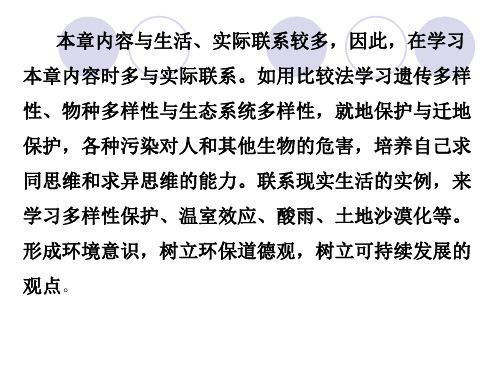
17、儿童是中心,教育的措施便围绕 他们而 组织起 来。2021/8/112021/8/112021/8/112021/8/11
2、Our destiny offers not only the cup of despair, but the chalice of opportunity. (Richard Nixon, American President )命运给予我们的不是失望之酒,而是机会之杯。二〇二一年六月十七日2021年6月17日星期四
我国主要一些人口因素变化与环境问题:(1)人口 总数变化与环境。由于我国人口总数大,而且还继续 保持增长的势头,所以对环境的压力依然存在。(2)就 业人员构成变化与环境。我国就业人员构成的变化比 较明显,人口大量由农业转向工业和其他产业,并且 这种人口转移将会继续下去。这有助于农村、农业环 境的改善,但有可能增加城市环境的压力。(3)人均收 入与环境。虽然环境库茨涅兹曲线说明人均收入与环 境问题有密切的关系,但对我国来说,人均收入不是 问题的关键,起作用的是经济总量。按照我国目前的 经济状况,我国有条件使环境不断得到改善。
A.决定人口数量变化的因素只有出生率和死亡率 B.出生率是预测未来人口动态的主要依据 C.人口数量问题既有其自然生理基础,又有其社会 制约因素 D.人口数量的变化规律与自然界种群数量的消长规 律相符合
[解析] 本题主要考查种群数量的变化与种群特征的关系。一 个国家或地区的全部人口可以看做是一个种群,它同样具有种 群的特征,这些特征都可以影响种群的数量变化、性别比例和 年龄组成,都可以影响未来种群的密度,但是它们对种群密度 的影响最终是通过影响出生率和死亡率来体现的。由于种种因 素的干扰,预测的出生率和死亡率未必能实现,特别是人类自 身的出生率,与该国家或地区的人口政策及人们的生育观念有 关。预测种群未来发展趋势的是年龄组成。对种群数量的动态 变化起决定性作用的因素是当时的出生率、死亡率和迁移率。
高中生物人教版必修三 稳态与环境高中必修3第6章第1节人口增长对生态环境的影响教案2
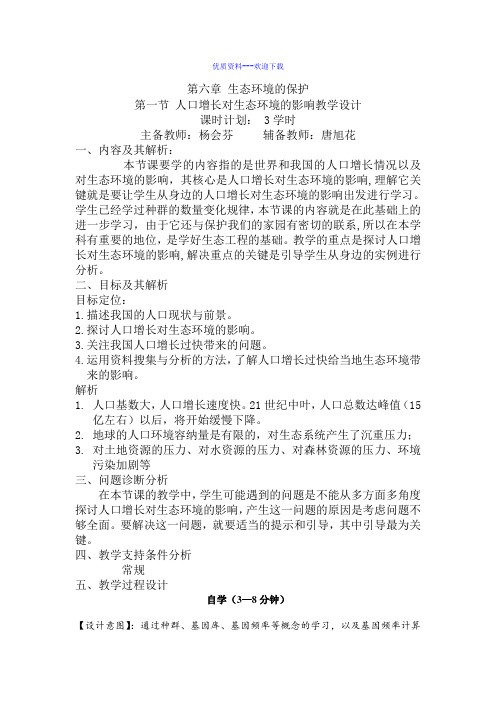
优质资料---欢迎下载第六章生态环境的保护第一节人口增长对生态环境的影响教学设计课时计划: 3学时主备教师:杨会芬辅备教师:唐旭花一、内容及其解析:本节课要学的内容指的是世界和我国的人口增长情况以及对生态环境的影响,其核心是人口增长对生态环境的影响,理解它关键就是要让学生从身边的人口增长对生态环境的影响出发进行学习。
学生已经学过种群的数量变化规律,本节课的内容就是在此基础上的进一步学习,由于它还与保护我们的家园有密切的联系,所以在本学科有重要的地位,是学好生态工程的基础。
教学的重点是探讨人口增长对生态环境的影响,解决重点的关键是引导学生从身边的实例进行分析。
二、目标及其解析目标定位:1.描述我国的人口现状与前景。
2.探讨人口增长对生态环境的影响。
3.关注我国人口增长过快带来的问题。
4.运用资料搜集与分析的方法,了解人口增长过快给当地生态环境带来的影响。
解析1. 人口基数大,人口增长速度快。
21世纪中叶,人口总数达峰值(15亿左右)以后,将开始缓慢下降。
2. 地球的人口环境容纳量是有限的,对生态系统产生了沉重压力;3. 对土地资源的压力、对水资源的压力、对森林资源的压力、环境污染加剧等三、问题诊断分析在本节课的教学中,学生可能遇到的问题是不能从多方面多角度探讨人口增长对生态环境的影响,产生这一问题的原因是考虑问题不够全面。
要解决这一问题,就要适当的提示和引导,其中引导最为关键。
四、教学支持条件分析常规五、教学过程设计自学(3—8分钟)【设计意图】:通过种群、基因库、基因频率等概念的学习,以及基因频率计算的联系,来理解种群基因频率改变与生物进化的关系。
【师生活动】【学生阅读】教材P114—115页内容,完成以下横线。
【教师讲解】种群、基因库、基因频率的概念及基因频率的计算方法互学、导学(15—20分钟)问题一:目前我国人口的现状怎样?发展前景如何?1.阅读问题探讨中的图片,思考:(1)造成人口如此拥挤的可能原因是什么?从表面上看,是由于人口在某一地区过于集中;从根本上看是由于人口增长,以及人口流动过于。
赵渺希《环境生态学》环境生态学复习提纲答案.doc
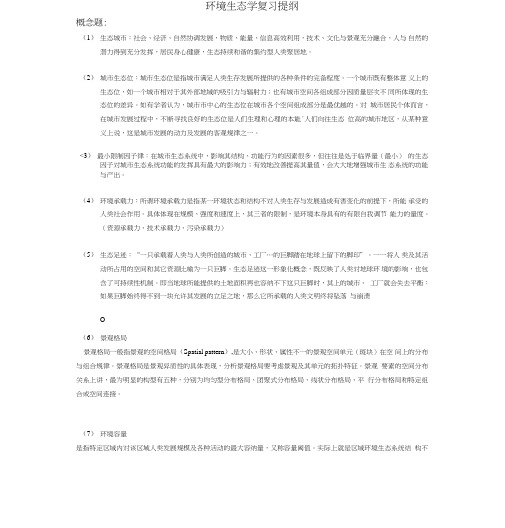
环境生态学复习提纲概念题:(1)生态城市:社会、经济、自然协调发展,物质、能量、信息高效利用,技术、文化与景观充分融合,人与自然的潜力得到充分发挥,居民身心健康,生态持续和谐的集约型人类聚居地。
(2)城市生态位:城市生态位是指城市满足人类生存发展所提供的各种条件的完备程度。
一个城市既有整体意义上的生态位,如一个城市相对于其外部地域的吸引力与辐射力;也有城市空间各组成部分因质量层次不同所体现的生态位的差异。
如有学者认为,城市市中心的生态位在城市各个空间组成部分是最优越的。
对城市居民个体而言,在城市发展过程中,不断寻找良好的生态位是人们生理和心理的本能°人们向往生态位高的城市地区,从某种意义上说,这是城市发展的动力及发展的客观规律之一。
<3)最小限制因子律:在城市生态系统中,影响其结构、功能行为的因素很多,但往往是处于临界量(最小)的生态因子对城市生态系统功能的发挥具有最大的影响力;有效地改善提高其量值,会大大地增强城市生态系统的功能与产出。
(4)环境承载力:所谓环境承载力是指某一环境状态和结构不对人类生存与发展造成有害变化的前提下,所能承受的人类社会作用。
具体体现在规模、强度和速度上,其三者的限制,是环境本身具有的有限自我调节能力的量度。
(资源承载力、技术承载力、污染承载力)(5)生态足迹:“一只承载着人类与人类所创造的城市、工厂…的巨脚踏在地球上留下的脚印”。
一一将人类及其活动所占用的空间和其它资源比喻为一只巨脚。
生态足迹这一形象化概念,既反映了人类对地球环境的影响,也包含了可持续性机制。
即当地球所能提供的土地面积再也容纳不下这只巨脚时,其上的城市、工厂就会失去平衡:如果巨脚始终得不到一块允许其发展的立足之地,那么它所承载的人类文明终将坠落与崩溃O(6)景观格局景观格局一般指景观的空间格局(Spatial pattern),是大小、形状、属性不一的景观空间单元(斑块)在空间上的分布与组合规律。
高考生物一轮复习 第六章 第38讲 生态环境的保护课件 苏教版必修3
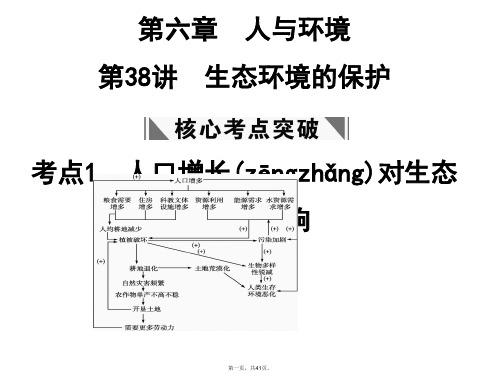
第一步:取一大号塑料袋排尽空气,收集化工厂废气若干。 取4盆长势相同(xiānɡ tónɡ)的葫芦藓,套上相同(xiānɡ tónɡ)大
第二步:_________________________________________
_袋__并__标_上__1_号、2号、3号、4号 。
第三步:1号盆注入200 mL空气,2号盆注入150 mL空气和 50 mL化工厂废气,3号盆__注__入__(_zh_ù_r_ù_)1_0_0__m_L_空__气__和__1_0_0_mL化工 _厂__废__气__,4号盆注入__5_0__m_L__空__气__和__1_5_0__m_L__化__工_ 厂废气,
第十三页,共41页。
即时突破
4.三峡大坝建成后,库区内许多(xǔduō)原有的特有物种面临灭 绝威
胁,为保护这些特有物种,最有效的保护措施是 ( )
A.就地保护
B迁地保护
C.建立自然保种无法在原地生存,为保
护这些物种应将它们移入动物园、植物园或其他专门地区
第十六页,共41页。
思路点拨:人体的生命活动离不开水,水的存在形式(xíngshì)包括 自由水和结合水,自由水参与许多化学反应比如呼吸作用 等,人体内水主要存在于细胞内液中,约占体液的2/3; 重金属污染会导致水生生物大量死亡,使生物多样性锐减; 蓝藻爆发的原因是水中N、P增多导致水体富营养化。 自主解答:________ 答案:B
注入气体后均密封。
第二十七页,共41页。
第四步:__放__4_盆__葫_芦__藓__在__室__温__(s_h_ì_w__ē_n_)下__培。养24 h 预测:经过24 h,可以得到无污染、轻度污染、中度污染和 重度污染的情况下的葫芦藓生存数。并以此作为指标预报污 染情况。 思路点拨:根据题意知,要求利用葫芦藓报告无污染、轻度 污染、中度污染和重度污染的情况,所以要设置4组实验。 在实验中所要控制的单一变量是不同浓度(nóngdù)的化工厂排出的废 气。设置实验时要遵循等量原则,即每一组所使用的气体量 是相同的,同时四组实验中所用生物的材料应保证其长势相 同,并放到同一环境条件下生长。 听课记录:________________________________________
生态学课件3 population

•
理想的数学模型的四性:
普遍性,准确性,真实性,简便性。
马尔萨斯 人口论
模型在生态学复杂现象研究中的作用
现实世界植被分布图
模拟世界植被分布图 (采用BIOME3模型)
种群模型的两类模型
• 种群的指数增长(又称“J”型增长或与密度
无关的种群增长模型)
• 种群的逻辑斯谛增长(又称“S”型增长或
与密度有关的种群增长模型)
学分支,按Tilman等著《空间生态学:空 间在种群动态和种间相互作用中的作用》 一书的定义,空间生态学是研究空间对于 种群动态和多种群(群落)的结构、动态、 多样性以及稳定型的影响。
二、种群的空间分布图式
• 种群的空间分布图式指种群的个体在其生存空间
的分布形式;
• 分布是数理统计学上变量的分布,可分为poisson
分布,正二项分布和负二项分布三种类型;
• 图式是指有机体在空间定位所表现出来的图式,
可分为随机分布、均匀分布和聚集分布
分布图式 均匀分布 随机分布 聚集分布
空间分布型 正二项分布 波松分布 负二项分布
三、种群空间分布图式的测定方法
• 方差(V)与平均密度(M)来测定
五、种群生态学研究热点及发展趋向
• • • • • • • • • • 构件理论 生殖生态学 与生理生态学结合研究 环境胁迫与生态型的发展 土壤种子库 行为生态学 种群调节理论 空间生态学 种内及种间关系 生物入侵或生态入侵
第二节
• • • •
种群的动态
种群的密度和分布 种群数量变动的参数 种群增长的数学描述 自然种群的数量变动
种群的指数增长模型
• 模型的假设与构建
• 离散性模型
•
连续性模型
【人教版】人口增长对生态环境的影响PPT精品课件1【精选】

•
3.古琦品牌时装一向以高档、豪华、 性感而 闻名于 世,以 “身份 与财富 之象征 ”品牌 形象成 为富有 的上流 社会的 消费宠 儿,一 向被商 界人士 垂青, 时尚之 余不失 高雅。 古琦现 在是意 大利最 大的时 装集团 。
•
4.继承着法国高级女装的传统,始终 保持高 级华丽 的设计 路线, 迎合上 流社会 成熟女 性的审 美品味 ,象征 着法国 时装文 化的最 高精神 。
【人教版高中生物】人口增长对生态 环境的 影响PPT 精品课 件1
关注全球生态环境问题
全球生态环境问题主要包括 全球气候变化、水资源短缺、臭氧 层破坏、酸雨、土地荒漠化、海洋 污染和生物多样性锐减。
【人教版高中生物】人口增长对生态 环境的 影响PPT 精品课 件1
【人教版高中生物】人口增长对生态 环境的 影响PPT 精品课 件1
•
5.多年过去了,这个名字依然引领着 世界的 流行时 尚。然 而在这 些辉煌 的业绩 后面, 我们所 看到的 是一个 活生生 的,他 充满着 深情, 极为害 羞,又 极为幽 默,他 便是永 远的。
•
6.迪奥的设计,注重的是服装的女性 造型线 条而并 非色彩 。他的 时装具 有鲜明 的风格 :裙长 不再曳 地,强 调女性 隆胸丰 臀、腰 肢纤细 、肩形 柔美的 曲线, 打破了 战后女 装保守 古板的 线条。 这种风 格轰动 了巴黎 乃至整 个西方 世界, 给人留 下深刻 的印象 。
【人教版高中生物】人口增长对生态 环境的 影响PPT 精品课 件1
【人教版高中生物】人口增长对生态 环境的 影响PPT 精品课 件1
间接使用价值
• 指生物多样性具有重要的生态功能
【人教版高中生物】人口增长对生态 环境的 影响PPT 精品课 件1
- 1、下载文档前请自行甄别文档内容的完整性,平台不提供额外的编辑、内容补充、找答案等附加服务。
- 2、"仅部分预览"的文档,不可在线预览部分如存在完整性等问题,可反馈申请退款(可完整预览的文档不适用该条件!)。
- 3、如文档侵犯您的权益,请联系客服反馈,我们会尽快为您处理(人工客服工作时间:9:00-18:30)。
The Patterns of Space Utilization
The Allee law
➢ Gregarious animals have an advantage on the survivor, therefore, they enjoy a low mortality rate.
➢ Population has its own proper density, less than or more then that value would cause an inhibiting influence to their existence.
➢ Pyramid shape is rapid growth, many young (Rwanda) ➢ Kettle(壶) shape is declining population (Hungary) ➢ Rectangular shape is zero growth, stable population
the mean(m) and variance(方差)
S2 (Xi)2 Xi 2/n n1
sample size
Population variance
Numbers of sample
if s2/m =0, then regular distribution if s2/m =1, then random distribution if s2/m≥1, then clumped distribution
The Patterns of Space Utilization
➢ Dispersing Utilization: Individuals, maybe families, get gather in a tiny space (realm), additionally, there are no other individuals of the same species living at the same time. It prevails at animals, e.g. panda, 3.9-6.4km2
Population Ecology
What Is Population Ecology?
Concept of Population ecology ➢The science that describes how and why
populations change
➢Populations may stay the same, increase, or decrease
➢ Maximum Birth rate: The birth rate of one population merely restrained by its physical factors is out of control of any type of limiting factors, namely, access to abundant resources.
A static life table: to record the age at death of a large number of individuals. Or from the age distribution, consisting of the proportion of individuals of different ages within a population.
A cohort life table: The most reliable way is to identify a large number of individuals that are born at about the same time and keep records on them from birth to death. (However…)
Life-history Traits from Life Table
➢ Survivorship curve: Type I , Type II , Type III
Proposed by Deevey (1947), plotting age on the X-axis and lg(survivors) on the y-axis creates a survivorship curve
What Are Characteristics for Population?
Population in Nature
➢ Gray Whales rounding the point of land on their way feeding grounds off the coasts of Alaska and Siberia in which the calves(仔) were born. They travel a distance of about 18,000km with the entire population of over 20,000 gray whaerns
Why Different Types?
Recognize Different Patterns
The first step toward testing statistically between these three
types of distributions is to sample the population to estimate
Population Dynamics
Basic Population Ecology Attribute
Birth rate & Death rate
➢ Birth rate: GBiertnherraaltley mreefearnsstothteheabailviteyraogfereapbriolitdyuoctfiorenpfroordpuecrtion for fNeeaamcrhraoliewn.dlyivmideuaanlss irnatoioneofpothpeulnautimonberar tohfeyrotuhnang bpoarrtnlyout of tcheertagirnosnsuimnboenres poof pinudlaivtiidouna. ls’ attribute.
What Are Characteristics for Population?
We can characterize individual populations in terms of there…
➢ Size (average vs. variation) ➢ Density (impacts on size; density dependence) ➢ Patterns of Dispersion ➢ Demographics (age structure, sex ratios) ➢ Rates of growth (or decline) ➢ Limits on population growth
Distribution : a description of how organisms are
distributed within their community. ➢Climate, topography and all kinds of the physical environment may limit the distribution of a population ( Natural Selection).
Common Characteristics for Population
Density : the measure of how crowded organisms are
in their environment.
➢Because organisms compete for resources, keeping a balance is important. ➢If the population is too high, some organisms will die. ➢Population density declines with increasing organism size.
Population Dynamics
Population Statistics Parameters
Age Distribution (Structure)
➢ distribution of males and females in each age group of a population
➢ used to predict future population growth ➢ Individuals are categorized by three physical phrase:
➢ Aggregating Utilization: Individuals aggregate in areas where the environment is favorable, What might be the pattern of distribution in all kinds of species.
➢ Mortality curves: show how quickly individuals die. ➢ life Expectancy: ex is known as the average lifetime to
(b)Monarch butterflies fly thousands of kilometers from the Rocky Mountains to reach their winter roost(栖木).
(a) The populations of gray whales migrate from subtropical waters off Baja California to the Arctic and back again.
